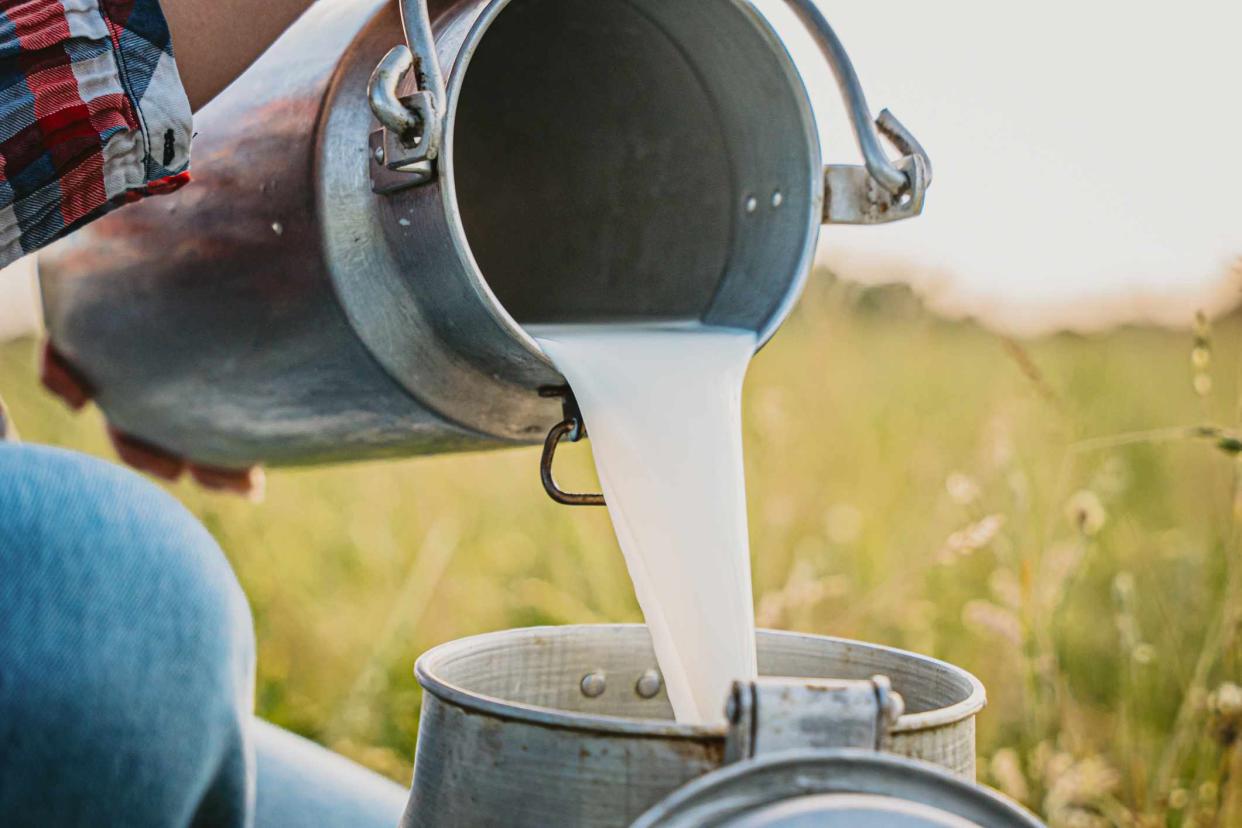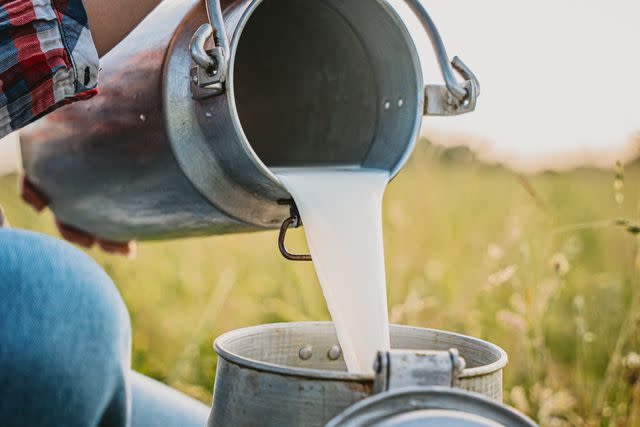Raw Milk Is Growing in Popularity—But Is it Safe to Drink?

Getty Images / SimonSkafar
Fact checked by Sarah Scott
Raw milk is now legal in many states, either via retail option, farm to consumer, or through herd shares.
Raw milk is milk that has not gone through the pasteurization process.
Experts note added safety risks associated with raw milk, primarily regarding an added risk of food-borne illness from consuming the product.
Raw milk is growing in legality, but some experts worry about the safety risks associated with the unpasteurized product.
State legislation around the sale of raw milk is slowly changing, with 27 states allowing people to sell raw milk directly to consumers. There are a variety of ways raw milk can legally be distributed—retail options, from farm to consumer, or through herd shares.
All of these distribution methods come with certain legislation that must be followed, largely to protect the buyer. As market demands continue to grow, many experts expect more states to expand legislation surrounding the sale of raw milk.
According to a 2022 consumer report, almost 5% of U.S. adults consumed raw milk at least once in the past year.
Some consumers claim that milk in its raw form can offer more health benefits than its pasteurized counterpart. But opting for unpasteurized milk doesn’t come without risk, and according to nutrition experts, drinking this type of milk may even be deadly in certain cases.

Getty Images / SimonSkafar
What Is Raw Milk?
Raw milk is simply dairy that has not gone through the pasteurization process. In other words, when milk goes directly from a cow's udder to the consumer, it's considered "raw."
Conversely, pasteurized milk involves heating every particle of milk to a specific temperature that prevents bacteria from thriving.
This pasteurization process is intended to make milk and milk products safe for human consumption by reducing the number of possibly harmful bacteria, as well as improving the shelf life of milk by reducing the number of spoilage bacteria.
"Routine pasteurization of milk began in the United States in the 1920s and became widespread by 1950 as a means to reduce contamination and reduce human illnesses," Karolin Saweres, MS, RDN, LD, registered dietitian nutritionist and wellness coach told Health.
Raw Milk vs. Pasteurized Milk
The biggest reason consumers are drawn to raw milk is due to the claim that it's a healthy, more nutritious option than pasteurized dairy. But experts agree that this seems to be blown out of proportion.
It is true that the pasteurization process can lower the percentage of certain vitamins found in milk, but it may not be as drastic as it sounds.
The heat used to pasteurize milk can result in a liquid that has less vitamin B12, vitamin E, vitamin C, folate, and vitamin B2 (riboflavin), but the overall effect of pasteurization on milk’s nutritional value is minimal—many of these vitamins are naturally found in relatively low levels anyways.
And while pasteurized milk may contain a slightly lesser percentage of certain vitamins, it can be argued that it makes up for it in peace of mind.
“Milk at the supermarket vs. raw milk has a major difference: safety,” said Kacie Barnes, MCN, RDN, a registered dietitian nutritionist. She explained that raw milk can carry harmful germs, such as Campylobacter, Cryptosporidium, E. coli, Listeria, Brucella, and Salmonella, which, when consumed, may cause food-borne illness.
People experiencing foodborne illness (more commonly referred to as food poisoning) can have diarrhea, nausea, fever, vomiting, and fatigue. In extreme cases, food poisoning can lead to kidney damage, brain damage, extreme dehydration, and even death.
Avoiding raw milk won’t be a surefire way to avoid food-borne illness—but it may help.
In the 1930s, when pasteurizing milk wasn’t legally required, milk-related illness outbreaks constituted approximately 25% of all disease outbreaks. At the beginning of the 21st century, when pasteurization was required, milk and milk products were associated with less than 1% of all such outbreaks, likely due to the pasteurization practice.
Accompanying the historic downtick in illness thanks to the pasteurization process, there are reports of people continuing to get sick from raw milk.
In 2005, an outbreak of 18 cases of infection with E. Coli found in raw milk occurred in Oregon and Washington states, mostly among children less than 14 years of age. In this outbreak, five patients were hospitalized. And from 2007-2009, 30 cases of foodborne illness in the United States were associated with raw milk consumption.
Raw dairy products are 840 times more likely to cause illness than pasteurized dairy products, according to the Centers for Disease Control and Prevention (CDC).
“Some of the pathogens found in raw milk can also cause serious life-threatening diseases like Guillain-Barré syndrome and hemolytic uremic syndrome,” Jamie Nadeau, RDN, a registered dietitian nutritionist told Health.
Related: Is Dairy Actually Healthy?
Deciding Between Raw Milk and Pasteurized Milk
No matter what the wellness trend you see online says, registered dietitians advise against the consumption of raw milk.
“One of the big reasons raw milk is picking up in popularity is because of social media,” Nadeau said. “Unfortunately, there is a lot of misinformation being spread about raw milk right now.”
She emphasized that there is truly no way to guarantee a raw milk product is safe, even if you get it from a farm you trust. "Regardless of how healthy the animals are or how well-maintained the farm is, you can still get sick,” she said.
While the pasteurization process comes with certain clarity surrounding food safety methods, raw milk contains a larger gray area.
No matter how clean a farm is, there are many ways that the cow’s milk can harbor potentially harmful bacteria, including germs from the cow’s feces coming into contact with the milk, the dairy utter having a mastitis infection, and the cow having a disease (like bovine tuberculosis).
Certain states may give you the option to purchase raw milk, but it's ultimately up to the consumer to make an educated, informed decision about the risk they may be taking.
According to Barnes, “certain populations are at higher risk for more severe illness [associated with consuming raw milk], including children, pregnant women, adults over 65, and anyone with a compromised immune system.”
Related: What Is Whey Protein—And What Are Its Benefits?
For more Health news, make sure to sign up for our newsletter!
Read the original article on Health.

